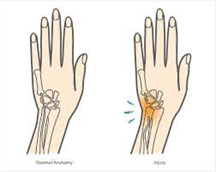ECU Subluxation
What is ECU Subluxation:
The ECU, or Extensor Carpi Ulnaris, is a muscle of the forearm that extends the wrist and allows your wrist to move backwards and toward your little finger. The muscle originates from the outer most point of your elbow and travels along the forearm to the hand, where it inserts into the fifth metacarpal, the bone that leads to the little finger.
The ECU tendon passes through a (fibrous sheath) tunnel at the base of the wrist (ulna), and when this sheath is injured, the tendon can be affected. This can occur from a single traumatic event or with repetitive use of the wrist.
What are the symptoms:
ECU subluxation is most often reported as a sharp pain to the affected area or near the prominent bone just before wrist (the ulnar styloid). In some instances, snapping or clicking sounds can also be felt and even heard. This pain may be aggravated with movement of the wrist toward the little finger or turning the palm up and down.


Conservative treatment:
Non-surgical treatment usually involves splinting your wrist in a circumferential wrist splint that prevents movement of the wrist and limits the hand from turning your palm up or down. Other splinting devices may include a “wrist widget” or “bulls-eye” – which support the wrist bones and protect the tendon from moving into a position that will aggravate pain. You might be provided with kinesio tape – this is applied in a position around the wrist that will support and de-load the tendon from painful positions and activation.
Your therapist will also commence a series of light exercises for you and discuss the importance of limiting forceful, repetitive or sustained use of your hand. Please see below.



Surgical Treatment:
If the sheath (tunnel) of the tendon has been ruptured/torn, you may require surgery to repair the sheath and hold the tendon within it. The wrist is then placed in a splint to protect the hand during the healing process – so hand therapy is still essential. The type of splint is usually determined by the surgeon but will almost definitely include your wrist and limit your ability to turn the palm up or down.
Gold Coast Hand Therapy’s Pearls of Wisdom:
This tendon is famous for being difficult to treat effectively. You will need the guidance of a trained Hand Therapist to navigate your journey to full recovery.
However, if you’re eager to start early there are a few things to consider:
- Heat will reduce the pain
The principles of R.I.C.E (rest; ice; compression; elevation) are tried, true and tested methods for effective management. However, after 48-72 hrs you may find that your pain does not respond to the ice as well. This is because the tendon is now healing past the inflammatory phase of the injury. You will benefit from Heat and light range of motion of the joints after this phase.
Usually a heat wheat wrapped around the wrist is the best method for pain management.
- Don’t wait for the oedema /swelling to go down before moving your wrist
Movement can aid the reduction of swelling in your hand and arm. Small movements of the wrist can promote our muscles to act as a pump for the swelling in our arm.
- Don’t focus on moving the wrist in a linear (straight – up & down) plane
The wrist moves in a complex pattern similar to its functional applications (Ie. Throwing). However, we must stress the importance of limiting repetitive movements, and to limit turning your hand over from palm up to palm down (supination / pronation).
- Don’t keep fingers straight /stiff with wrist movement
As we know, the wrist moves in a complex pattern. In this, we know that the muscles that move the fingers can also prime the movement in the wrist. Its important to let your fingers relax with the movement of the wrist. Usually the fingers will curl into a fist when the wrist extends (backwards) and straighten out when the wrist flexes (forward). This is called tenodesis
- Don’t force it
Whilst there are occasions for pushing our limits to create movement, this is probably not the right time. Avoid using your other hand to pull the wrist forward and backward (flexion or extension).
- Avoid push ups!
For many of us, this may be welcomed news! But any forceful pressure through the wrist may return the pain or even kick-start the inflammatory process all over again.
Final Thoughts:
ECU Tenosynovitis is an injury to the wrist that can occur to virtually any person in any industry. The tell-tale signs are usually pain arising along the outside border / little finger side of the wrist (near the ulnar styloid) and can even cause a clicking sound when you move the wrist.
In any instance, the earliest treatment is always the most effective. So please contact a trained Hand Therapist if you suspect that you may be experiencing any of these symptoms.